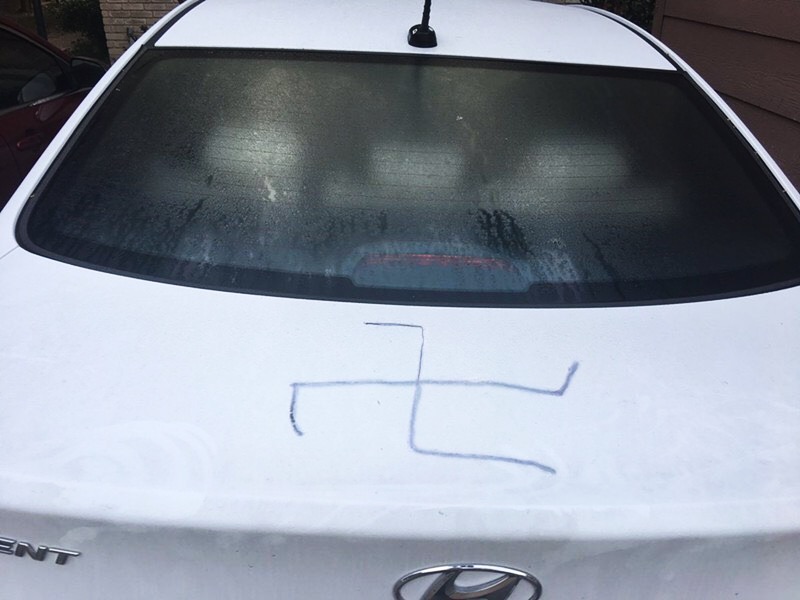“I deciphered the message, ‘its over fa**ots,’ and we all agreed the message was political in nature.” UTSA alumnus Drew Galloway said when describing the discovery of vandalism on his car in a police report. “I asked the officer if the crime would be classified as a hate crime and was told it would not because there was no suspect – it would be classified as graffiti instead.”
Four days after this, Galloway discovered a large swastika scrawled onto the trunk of his car.
Galloway’s partner, Martin, and their two children’s sense of security was shaken after their car was vandalised with the homophobic slurs and a swastika; a response to the crime was the next move.
The course of action following a hate crime can be obscure. The trauma of being targeted paired with the general infrequency of hate crimes (the latest FBI hate-crime statistic available reported 5,850 hate crime incidents in 2015) pose as challenges to finding concrete answers about a response.
Immediately, Galloway reported the vandalism to the San Antonio police.
“While reporting hate crimes can be very difficult emotionally, talking with law enforcement authorities is absolutely essential to keeping our community safe from bias-based crimes and discrimination.” Galloway said. “We cannot allow these acts to spread in our city. We all – victims, protectors and allies – must speak out against these incidents and do everything possible to ensure hate crimes are properly acted upon by law enforcement and elected officials.”
Many targeted attacks are filed as different crimes. This can be problematic for a victim who wants an accurate report of how they were harmed and what to identify it as.
For Galloway, the two targeted attacks on his personal property was certainly a hate crime.
“I began calling SAPD to inquire about why the crime was not listed as a hate crime. Each time, I was told it was because there was no suspect; if a suspect was located, the charge of graffiti could be escalated to a hate crime.”
The crime was not filed as a hate crime until the media became involved. Galloway said after KENS5 questioned the SAPD the crime immediately escalated into an anti-homosexual hate crime.
Media exposure to the crime was prompted by social media. Galloway took to Facebook and Twitter to share his experience with his network as well as contact city officials.
Then came results.
Councilman Ron Nirenberg and Councilwoman Shirley Gonzales’ office reached out to him directly. Several other members of city council responded to him on Twitter.
“The news stations reacted quickly,” Galloway said. “I called Mayor Ivy Taylor’s office and our Councilman Mike Gallagher’s office directly; I spoke with Mayor Taylor in the afternoon but never heard from Councilman Gallagher (in either instance).”
Though the SAPD assured Galloway that both crimes would be listed as hate crimes, the office of Diversity and Inclusion said both crimes would not fall under the protections of the Non-Discrimination Ordinance.
“This was extremely disappointing,” Galloway said. “We need the Non-Discrimination Ordinance to protect victims of hate crimes, which means strengthening the ordinance’s scope and reach.”
In hindsight, Galloway discussed possible measures that would have helped him and his family.
He felt that standardized methods of locally reporting hate crimes, such as clearer definitions of hate words/phrases and symbols would have helped the officers record the the crime accurately.
“We need hate crime data released to the local public in a timely manner,” Galloway said. “Local open data initiatives and access to aggregated crime SAPD statistics could help the tech community bring some solutions to the table.”
The FBI analyzes local hate crime reports and releases aggregated data annually. This information helps identify trends and track hate organizations across the United States.
Calling for appropriate intervention is critical but grassroot efforts to combat hate-charged crimes in one’s own community is equally important. As Executive Director of MOVE San Antonio, Galloway employed his civic knowledge to a cause close to home. MOVE is scheduled to provide training on a responsible report and if necessary, intervention of harassment in one’s community.
“MOVE San Antonio’s training comes at a time of great importance.” Galloway said. “Reports of hate crimes have skyrocketed since the election.”
MOVE U Civic Education Series, MOVE San Antonio is hosting a Bystander Intervention Training workshop on Dec. 6, 2016 from 5:30 – 7:00 p.m. in the Bexar Room at UTSA. They will talk about bias-based discrimination and crimes; how to support vulnerable communities and victims of hate acts; and how to safely report, intervene and deescalate discriminatory threats and acts. The training will aim to give students and community members practical skills to help protect their neighbors from verbal, physical and sexual abuse.
“Young people are champions of vulnerable communities in our city and instrumental in demanding change to protect their classmates, friends and neighbors,” Galloway concluded. “We’re the ones we have been waiting for and the time to act is now.”








